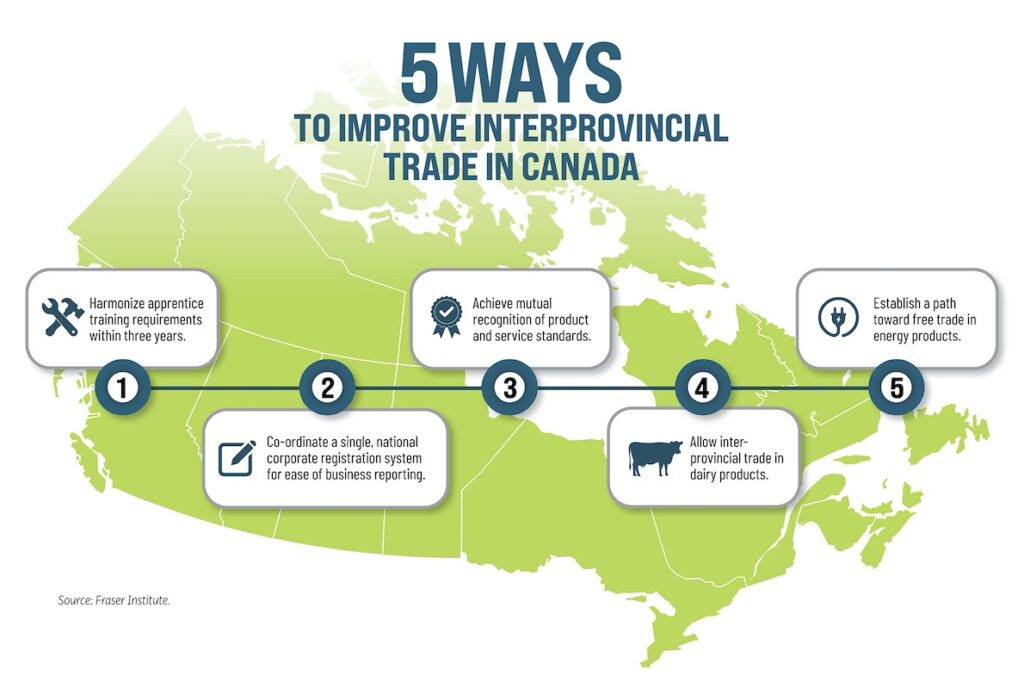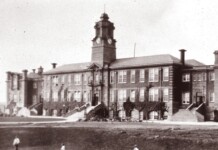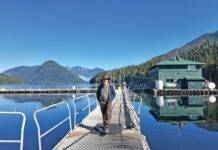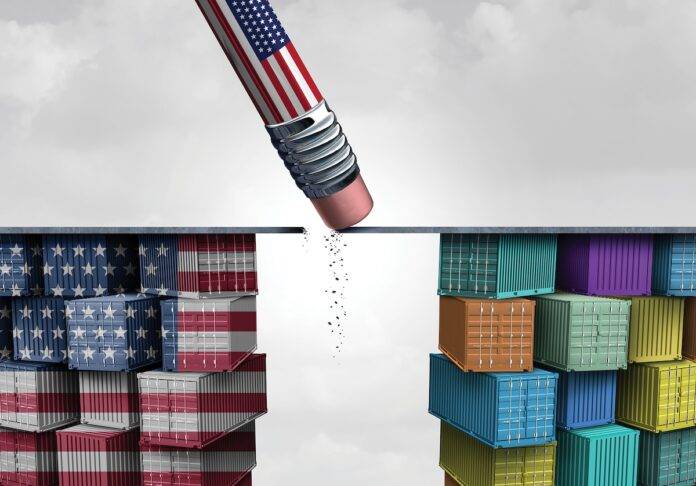Cam Matthews feels like he’s in the crosshairs of U.S. President Donald Trump and his America-first tariff strategy. As a senior mechanical engineer, Matthews leads a small team of engineers at York Machine Shop. In business since 1983, the Campbell River outlet makes milling machines, metal lathes and other precision tools designed for portability and remote applications. In 2017, York was bought by the Texas company Superior Plant Rentals.
Most of York’s customers, including the United States defence industry, are American. “We’re a perfect example of what MAGA [Make America Great Again] is trying to do, to move production to the U.S. If our product suddenly gets a lot more expensive, we’re going to experience a huge drop in sales,” Matthews told Douglas magazine. Matthews, of course, isn’t alone. Businesses and governments around the world have been rocked by the fallout from, and unpredictability of, the Trump administration’s evolving economic policies since it came to office in January.
Within two months the U.S. signalled it would be treating Canada in a very different manner from before, beginning on March 4, when it slapped tariffs of 25 per cent on Canadian goods and 10 per cent on energy and potash. By mid-month, it hit Canadian steel and aluminum with a 25-per-cent tax, and come early April, a 25-per-cent tariff on Canadian automobiles took effect.
Trump’s actions prompted a retaliatory response from Canada, turning what was once a positive trade relationship between besties into a nasty narrative of tit for tat between squabbling neighbours.
For Matthews and the 42 engineers, machinists, draftspeople and office staff employed at York, this trade war represents an existential threat.
Winners, Losers and Red Herrings
The tale of York Machine Shop could be a metaphor for Trump 2.0’s unprecedented trade war. Any way you view it, people and businesses on both sides of the border will bear the brunt of tariff-induced higher prices. And just as runs an integrated cross-border business with subsidiaries on both sides of the 49th parallel, our economy is deeply — and currently painfully — integrated.
According to a recent Scotiabank analysis, 77 per cent of Canada’s exports go to the United States. On paper it is a daunting U.S.-dependent trade relationship, says Jason Hicks, an American-born University of Victoria economist who, along with his wife, just got permanent residency in Canada.
“It’s unlikely Canada could sustain a trade war over the long term without sustaining some serious damage to its economy,” Hicks says.
If that sounds like it’s stating the obvious, well, it is, admits Hicks. However, a deeper dive into the current Canada-U.S. discord reveals a much more nuanced picture. The challenge is parsing out true intentions from bluster when the news cycle can barely keep pace with the American president’s daily on-again, offagain trade and tariff pronouncements.
“We know that Donald Trump is transactional in his approach. He views trade as a zero-sum game where there’s a winner and loser,” Hicks says. That’s counter to the spirit of trade agreements, like 2020’s Canada-United States-Mexico Agreement (CUSMA) and its predecessor NAFTA (North American Free Trade Agreement), which are meant to be mutually beneficial.
Hicks says it is possible that Trump sees tariffs simply as a method of extracting benefits from trading partners, such as Canada’s appointment of a new drug czar to tackle the flow of fentanyl into the U.S. But as the United States’s own data shows, the amount of this toxic drug entering from Canada is a trickle compared to the amount that arrives from other countries.
In other words, it’s a red herring, a flimsy justification for tariffs. Or Trump may indeed believe that tariffs can force manufacturing back to the U.S., despite studies of his 2018 tariffs showing they had little impact in this respect. Nobody knows, and if there’s one thing businesses hate, whether they’re flying the Maple Leaf or the Star-Spangled Banner, it’s uncertainty.
The current trade climate is rife with uncertainty that Hicks believes could and may already be backfiring on Trump.
“When Trump imposed tariffs in 2018 during his first term, it had very little impact on reshoring of manufacturing. It requires massive investment in building infrastructure and training employees and no company is going to take on that risk without certainty in the trade environment,” Hicks says. That gives some comfort to Matthews and his fellow staff at York Machine Shop. However, that’s just a single thread in a narrative with many threads.
B.C.’s Trade Position and Economic Solidarity
The South Island Prosperity Partnership (SIPP) is taking a big-picture look with the creation of Rising Economy Taskforce 2.0, which is bringing together business leaders to unpack what a protracted trade war with the U.S. means for Vancouver Island and B.C.
“We’re looking at the real impact of uncertainty and unpredictability on a dayto-day basis for businesses, how we can adapt to tariffs and what weaknesses and vulnerabilities these tariffs expose on the South Coast,” says SIPP CEO Aaron Stone, who is chairing the task force.
These are big questions with complicated answers, and it’s important to understand B.C.’s trade position within the national context.
Over the first three quarters of 2024, Canada exported $800 billion of product to the U.S., second only in export value to Mexico, with energy and automotive parts and products topping the list of Canadian exports. At the same time, Canada imported $350 billion worth of product from the U.S., making us America’s largest single export market with 34 states selling more to Canada than any other country. According to a TD Bank analysis, this puts the lie to Trump’s claims that the U.S. is subsidizing Canada’s economy.

As a province, B.C. will be much less affected by tariffs than the more manufacturing-based economies of Quebec and Ontario. In 2023, B.C.’s exports to the U.S. totalled $31 billion, accounting for 54 per cent of our total exports, but just seven per cent of provincial GDP, the lowest of all provinces.
But that doesn’t mean we’re immune. B.C.’s forest sector, already struggling, will feel the sting of Trump tariffs. The industry has been bogged down for decades in a softwood lumber dispute with the U.S. A 25-per-cent tariff piled on top of the current 14-per-cent duty paid by B.C. lumber exporters could have a huge impact on a city like Port Alberni, where up to 500 people are employed in forestry-related businesses.
A weak Canadian dollar could partially offset the impact of tariffs because it makes our exports more attractive to trade partners. It’s the reason some analysts predict slow growth for the Canadian economy through 2025 despite the turmoil.
Stone says he’s “bullish” about the future and views the current dysfunction in North American trade as an opportunity to address some longstanding pain points in the Canadian economy.
Removing interprovincial trade barriers has leapt back to the top of the economic development agenda, but Stone cautions that it’s been discussed before, only to be dropped.
Canada’s sagging labour productivity, defined as the value created per hour worked, is another perennial weakness. In 2022, Canada’s productivity was 71 per cent of that in the U.S., and B.C.’s has dropped consecutively for the last four years. Many critics, like David van Hemmen, vice-president of the Greater Vancouver Board of Trade, blame stringent regulations and an unfavourable business investment climate for Canada’s low productivity. According to Stone, Victoria’s productivity lags even further behind the B.C. average, though he says this is due in part to the large percentage of civil servants in the provincial capital. Still, he sees an opportunity.
“I just hope that we keep up this momentum on interprovincial trade and start harmonizing regulations, regardless of how this trade war unfolds.” — Aaron Stone, SIPP CEO
“This is where we can really lean into initiatives like the Ocean Innovation Hub, encourage investment in value-added, and support businesses as they diversify and adapt,” Stone says. “Victoria is a wonderful place. We have talent, we have the ocean and we have the geography. I really see this as a clarion call for Canadians to work together and build more economic solidarity.”
Unintended Positive Consequences
Canada’s overwhelming dependence on the U.S. as a trading partner has also been brought into sharp focus. Stone says that SIPP supports the efforts of the Ministry of Jobs, Economic Development and Innovation, which in the past few months has opened trade offices in Mexico, Taiwan, Vietnam and the Philippines, as part of B.C.’s Trade Diversification Strategy.
“We’re going to make sure that we’re never again in the position, certainly British Columbia is going to do this, of being so exposed to the whims of one person in the White House,” Premier David Eby told reporters in early February at North Vancouver’s PKM Canada port terminal where a docked ship loaded with copper concentrate was bound for Asia instead of the U.S.
Diversifying trade could give Canada leverage with the U.S. at the bargaining table, but nothing will change the reality of geographic proximity. Canada and the U.S. share an 8,900-kilometre border. Robust trade between our countries makes economic sense.
There are other signs that Trump’s tariff war will backfire. Americans, especially from the Pacific Northwest, love to visit Vancouver Island. In 2023 nearly 300,000 Americans came to the Island and spent money on hotels, restaurants, whalewatching tours, sport fishing and myriad other experiences.
“The concern is that tourism is immune from the impacts of tariffs, but if things get more expensive in the U.S. and Americans have fewer resources, they won’t travel,” says Brian Cant, vice-president of business impact and engagement for 4VI social enterprise group. So far that hasn’t been the case.
The number of Americans visiting Canada was up 21 per cent in January compared to the same month in 2024. On Vancouver Island, where the tourism sector is worth $3.2 billion in annual spending, some experts are even predicting a bump in visitors, whether they are Americans taking advantage of the low Canadian dollar or Europeans wanting to avoid the U.S.
Already Destination Greater Victoria has seen one unexpected benefit from the tariff war: an increase in conferences. “We’re seeing a record convention year. Conventions are at capacity,” says Paul Nursey, CEO of DGV. In 2023 the city hosted 20 conventions; this year it’s scheduled to host at least 30, some of which had originally been planned for U.S. markets. “We’ve been able to repatriate some of those.” Still, Nursey says: “It’s a very uncertain time. Tariffs are driving all sorts of uncertainty and our industry relies on confidence. In the short term we are going to be OK, but none of this uncertainty is going to be good for any sector.
Through Q3 it’s still going to be pretty good, but after that it’s hard to say.” He adds: “If there’s a trade war worldwide, that will affect the whole economy and that will affect travel, too.” Where tourism may be looking rosy on this side of the border, it’s a different scenario on the other side of the 49th parallel.
Canada is the top source of international visitors to the U.S., but recent data shows airline bookings from Canada for the summer season are down a whopping 70 per cent. The U.S. Travel Association warned that a 10-per-cent drop in Canadian traffic could cost the country $2.1 billion in spending and 14,000 jobs.
UVic’s Hicks says tourism is one example of the complexity and unintended consequences of a trade war. Another is a potential brain drain. There are early signs that academics and medical professionals affected by Trump’s cuts to science and health care are starting to look north of the border. This could be a big win for Canadian research and a solution to the growing doctor shortage. According to the Medical Association of Canada, the number of U.S. medical graduates opening accounts on the physiciansapply.ca site jumped 583 per cent between October 2024 and March 2025.
Business as Unusual
Back in Campbell River at York Machine Shop, Cam Matthews and his staff will continue to do what they do, designing and manufacturing precision machines that a lot of American customers want.
When asked about Canadian trade in early March, President Trump told reporters: “We just don’t need their product.” He might live to eat those words, and in the end it could be pressure from within that will force the issue.
For instance, in a recent CBC interview, Doug Sombke, president of the South Dakota Farmer’s Union, called the tariffs a “horrible idea,” saying: “Whoever thought that tariffs were good for the country, they really don’t understand civics and/or economics very well.” Meanwhile, Matthews notes an ironic twist to the story of York Machine Shop and its Texas parent company. “All of my Gulf Coast colleagues voted for Trump,” he says, “and now it’s hurting their company.”
























